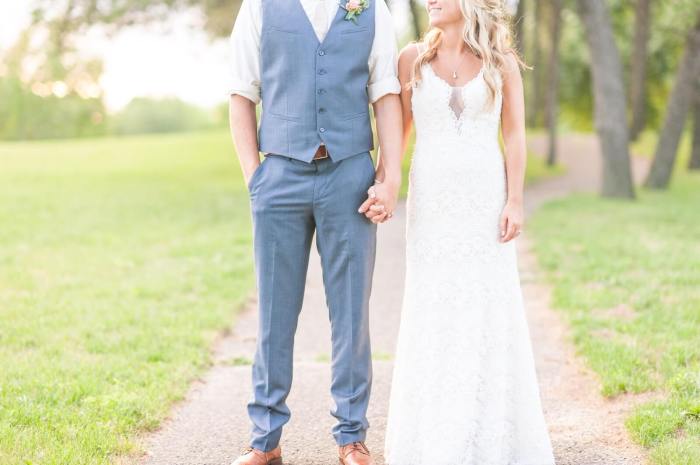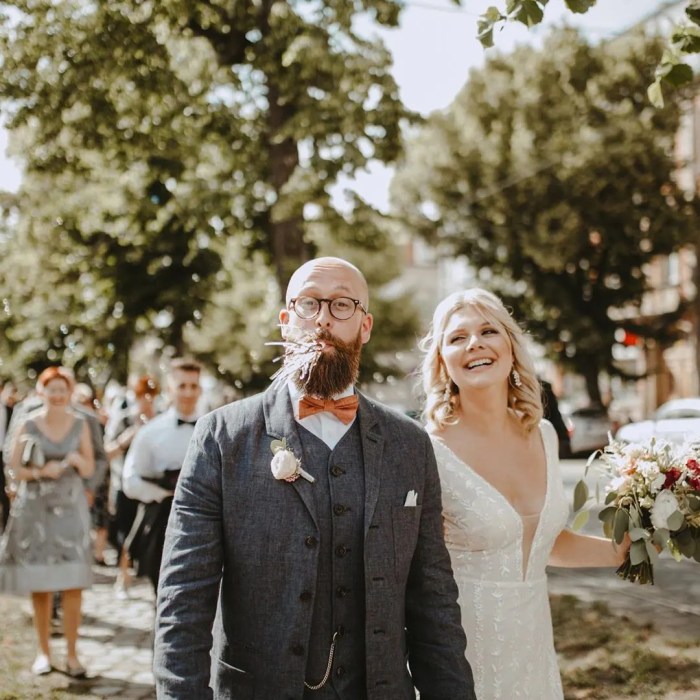Wedding Reception Dress for Groom A Style Guide
Styles of Groom’s Reception Attire
Wedding reception dress for groom – The groom’s reception attire has undergone a significant transformation over the past fifty years, reflecting evolving societal norms and fashion trends. While traditional formal wear remains a classic choice, modern grooms are increasingly embracing more relaxed and personalized styles.
Evolution of Groom’s Reception Attire
Fifty years ago, the tuxedo was the undisputed king of groom’s attire. Dark suits, often paired with bow ties and cummerbunds, were the norm. Today’s options are far more diverse, ranging from classic suits in various colors and fabrics to more casual options like linen suits or even well-tailored blazers and chinos. The shift reflects a move towards greater personalization and comfort, allowing grooms to express their individual style.
Traditional vs. Modern Groom’s Attire
Traditional formal wear, typically a tuxedo or a dark-colored suit with a tie or bow tie, conveys sophistication and elegance. Modern options offer greater flexibility. Slim-fit suits, lighter-colored suits, and even more casual ensembles are now widely accepted, reflecting the couple’s personal preferences and the overall wedding style.
Reception Outfit Designs for Different Wedding Styles
Three distinct reception outfits illustrate the versatility of groom’s attire:
- Rustic Wedding: A light brown linen suit with a cream-colored linen shirt and a brown leather belt. The overall palette is warm and earthy. A simple woven tie or no tie at all would complete the look.
- Formal Wedding: A classic black tuxedo with a crisp white shirt, black bow tie, and patent leather shoes. This ensemble exudes timeless elegance and sophistication.
- Beach Wedding: A light gray or navy blue linen suit with a light blue linen shirt and loafers. This breezy outfit is perfect for a relaxed beach setting. A colorful patterned tie could add a pop of personality.
Suit Styles for Various Wedding Settings
The appropriateness of different suit styles depends largely on the wedding’s formality. Tuxedos are ideal for black-tie events, while slim-fit suits are versatile for semi-formal weddings. Classic suits provide a timeless and elegant look suitable for a range of settings. More casual settings might allow for tailored blazers and chinos.
Fabrics and Textures for Groom’s Reception Attire
The choice of fabric significantly impacts the comfort, formality, and overall appearance of the groom’s reception attire. Understanding the properties of different fabrics is crucial for selecting an outfit appropriate for the season, setting, and personal style.
Advantages and Disadvantages of Different Fabrics

Source: vieroweddingdresses.com
Linen is breathable and comfortable for warm weather but wrinkles easily. Wool is warm and durable but can be heavy and less breathable. Silk is luxurious and elegant but requires delicate care. Cotton offers a good balance of comfort, durability, and affordability.
Impact of Texture on Overall Look
Smooth fabrics create a sleek and polished look, while textured fabrics add visual interest and depth. Patterned fabrics can add personality and flair. The texture should complement the overall style of the wedding and the groom’s personal preference.
Comparison of Fabrics

Source: shgcdn.com
| Fabric | Comfort | Formality | Price |
|---|---|---|---|
| Linen | High (warm weather) | Medium to High | Medium |
| Wool | Medium (cooler weather) | High | High |
| Silk | Medium | High | High |
| Cotton | High | Medium | Low to Medium |
Choosing Fabrics for Different Seasons and Climates
Lightweight fabrics like linen and cotton are ideal for warm weather, while heavier fabrics like wool are suitable for cooler climates. Consider the season and climate when selecting the fabric for the groom’s reception outfit to ensure comfort and appropriateness.
Color Palettes and Coordination with the Bride: Wedding Reception Dress For Groom
The groom’s attire should complement the bride’s without directly matching. A subtle color coordination creates a harmonious and visually appealing effect. The color palette should reflect the wedding’s theme and overall aesthetic.
Color Palettes for Different Wedding Themes
- Rustic Wedding: Earthy tones like beige, olive green, and brown.
- Formal Wedding: Classic colors such as navy blue, black, or charcoal gray.
- Beach Wedding: Light and airy shades like light blue, ivory, and beige.
Avoiding Color Clashes
Avoid clashing colors by considering the overall color scheme of the wedding. For example, a bright red suit might clash with a pastel wedding palette. Harmonious color combinations create a visually pleasing effect.
Using Accessories to Add Color and Personality
Ties, pocket squares, and other accessories offer opportunities to add color and personality to the groom’s outfit. A subtly patterned tie or a brightly colored pocket square can add a touch of individuality without overpowering the overall look.
Accessories and Personalization
Accessories play a crucial role in personalizing the groom’s reception attire, reflecting individual style and adding unique touches to the overall look. Careful selection of accessories can elevate the ensemble from simple to sophisticated.
Accessory Sets for Different Personal Styles
- Classic: A simple tie, classic cufflinks, and dress shoes.
- Modern: A slim tie, patterned pocket square, and modern loafers.
- Bohemian: A patterned bow tie, unique cufflinks, and suede shoes.
Expressing Individuality with Accessories
Accessories allow grooms to inject personality into their attire. A vintage watch, unique cufflinks, or a patterned tie can reflect personal style and add character to the outfit.
Types of Shoes for Groom’s Reception Attire
Dress shoes, loafers, and even stylish boots can be appropriate depending on the wedding’s formality and the groom’s personal style. Comfort is also a key consideration.
Selecting Appropriate Jewelry
Cufflinks and a watch are classic choices for groom’s attire. The jewelry should complement the outfit and reflect the groom’s personal style. Avoid overly flashy or ostentatious pieces.
Budgeting and Sourcing
Planning a budget and identifying reliable sources for the groom’s reception attire is essential for a stress-free and financially responsible approach to wedding planning. A well-planned budget ensures that the groom’s outfit aligns with the overall wedding budget.
Budget Breakdown for Groom’s Reception Outfit
A sample budget might include: Suit ($500-$1500), Shirt ($50-$150), Tie ($50-$150), Shoes ($100-$300), Accessories ($50-$200), Alterations ($50-$150).
Potential Sources for Groom’s Reception Outfit
- Department stores
- Tailors
- Online retailers
- Men’s boutiques
Finding Affordable Yet Stylish Options
Shopping during sales, considering renting a suit, or opting for less expensive fabrics can help find affordable yet stylish options. Prioritizing key pieces and accessorizing strategically can maximize the impact of the budget.
Ready-Made vs. Custom-Tailored Suits
Ready-made suits offer convenience and affordability, while custom-tailored suits offer a perfect fit and personalized style. The choice depends on budget, time constraints, and desired level of personalization.
Post-Reception Care and Maintenance
Proper care and maintenance of the groom’s reception attire ensure its longevity and preservation as a cherished keepsake. Understanding the specific care instructions for different fabrics is essential.
Proper Care and Maintenance of Fabrics, Wedding reception dress for groom
Linen should be dry-cleaned or hand-washed carefully. Wool should be dry-cleaned. Silk requires delicate hand-washing or professional dry cleaning. Cotton is generally machine washable.
Storing the Groom’s Reception Outfit
Store the outfit in a breathable garment bag in a cool, dry place. Avoid storing it in direct sunlight or in damp conditions. Proper storage prevents wrinkles and damage.
Selecting the perfect wedding reception dress for the groom often involves considering the overall wedding theme. This decision can be significantly influenced by the attire of the wedding guests, so checking out options for wedding guest dress nearby can offer valuable insight into the overall style. Ultimately, the groom’s attire should complement the wedding’s aesthetic and create a cohesive look, reflecting his personal style as well.
Removing Common Stains
Address stains promptly. Follow the fabric care instructions for stain removal. For stubborn stains, consider professional dry cleaning.
Preserving the Outfit as a Keepsake
Professional cleaning and proper storage are essential for preserving the outfit. Consider having it professionally preserved for future generations.
Key Questions Answered
What is the difference between a tuxedo and a suit?
A tuxedo typically features satin lapels and facings, while a suit does not. Tuxedos are generally considered more formal.
How far in advance should I start shopping for my reception outfit?
Ideally, start shopping 3-6 months before the wedding to allow ample time for alterations and fittings.
Can I wear a different outfit for the ceremony and reception?
Yes, many grooms choose to wear a different outfit for the reception, often opting for something more relaxed and comfortable.
What should I do if I spill something on my outfit during the reception?
Act quickly! Blot (don’t rub) the stain and seek professional cleaning as soon as possible.
















